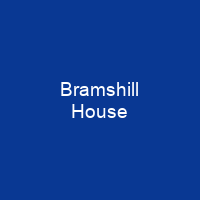Bramshill House: A Time Capsule of History
Imagine stepping into the pages of history, where every stone whispers tales of bygone eras. Bramshill House, nestled in the northeast Hampshire countryside, is such a place. This Jacobean prodigy house mansion, built in the early 17th century, stands as a testament to architectural grandeur and historical significance.
The Architectural Marvel
With its three-storey structure, Bramshill House is not just a building; it’s an intricate puzzle of history. The design was heavily influenced by the Italian Renaissance, executed mainly by German builders. This unique blend of styles makes it a true prodigy house, a marvel that defies categorization.
Traditionally attributed to architect John Thorpe, although no records confirm this attribution, the building features a unique plan with an incorporated earlier building and asymmetrical elevations. Stone mason Richard Goodridge was involved in its construction in 1617 and 1621, adding his touch to what would become a masterpiece.
A House of Many Facets
Step inside Bramshill House, and you’ll find yourself surrounded by rich history. The Great Hall retains its original design with a dais, Jacobean stone screen, and 92 shields. Resident families decorated these shields with ancestors’ arms, creating a visual tapestry of generations past.
The drawing room is panelled with oak, 16 feet high, and has a frieze depicting foliage. The library boasts a massive chimneypiece designed by Giacomo Barozzi da Vignola, featuring Doric and Ionic columns. The fireplace in the drawing room retains ancient andirons used for burning wood.
The ceilings of the drawing room and library are elaborate, with the library having housed 5,000 volumes before the Cope family took it over. The staircase has standards and balusters from Eversley Manor House, possibly dating to mid-17th century. Beyond the staircase are state rooms including the ‘Wrought Room’ with a Renaissance chimneypiece and two ‘White Rooms’.
The Long Gallery on the first floor is 126.5 feet long with stucco ceiling and wooden chimneypiece, formerly containing portraits of distinguished characters.
On the first-floor south wing, you’ll find the Chapel Drawing Room connected to the Drawing Room. The current chapel has an altar reredos with paintings dated about 1840 and a tapestry older than the house, dating back to 1450 or earlier.
The Haunted History
Bramshill House is not just haunted by its history; it’s said to be one of the most haunted houses in England. With 14 ghosts identified by a UK police officer, these spirits add an eerie yet fascinating layer to the house’s allure.
- The Grey Lady: seen in various locations such as the terrace, library, and chapel.
- The Green Man: possibly related to a Cope family member who drowned near the lake.
- A ghost of a gardener: seen near the lake.
- A young child: heard crying and attempting to hold visitors’ hands, reportedly in the library and Fleur de Lys room.
- The Lady in 17th-century dress: seen in the chapel drawing room.
- A nun: seen in the chapel.
- A young man in 1920s tennis garb: possibly a Cope family member who fell from a train.
- A small boy: documented to haunt the terrace, reportedly fallen from the roof in the 18th century.
The Grounds and Beyond
Beyond its architectural wonders, Bramshill House boasts an impressive 262 acres of land. The grounds include an 18-acre lake, early 17th-century formal gardens, and wider medieval park landscapes. The Grade I listed gatehouse dates back to the time of the Foxleys, and fir trees were planted ‘as a memento’ by James I.
Kingsley, a friend of Sir John Cope, was particularly fond of fir trees at Bramshill House. The house has been reported as one of the most haunted in England, with 14 ghosts identified by a UK police officer. These include:
- The Grey Lady: seen in various locations such as the terrace, library, and chapel.
- The Green Man: possibly related to a Cope family member who drowned near the lake.
- A ghost of a gardener: seen near the lake.
- A young child: heard crying and attempting to hold visitors’ hands, reportedly in the library and Fleur de Lys room.
- The Lady in 17th-century dress: seen in the chapel drawing room.
- A nun: seen in the chapel.
- A young man in 1920s tennis garb: possibly a Cope family member who fell from a train.
- A small boy: documented to haunt the terrace, reportedly fallen from the roof in the 18th century.
The legend of the Mistletoe Bough is also associated with Bramshill House. It tells the story of a bride who was found wearing her wedding dress and holding mistletoe 50 years after hiding in a chest during a game of hide and seek.

Bramshill House is more than just a house; it’s a living, breathing entity that continues to captivate and intrigue visitors. From its architectural marvels to its haunted history, this Jacobean prodigy house mansion remains a true gem of English heritage.
You want to know more about Bramshill House?
This page is based on the article Bramshill House published in Wikipedia (retrieved on November 28, 2024) and was automatically summarized using artificial intelligence.






